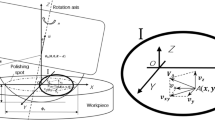Abstract
The M-shaped tool influence function (TIF) usually comes out when adopting a large tool offset at the high-efficiency polishing stage in bonnet polishing. Its modeling is as important as the Gaussian-like TIF for the polishing process. However, the existing reports on the TIF of bonnet polishing are mostly about the Gaussian-like TIF model, or the model which cannot accurately simulate the M-shaped TIF. Viewing this, an optimized TIF model about the semirigid (SR) bonnet tool is presented based on the finite element analysis method which can be used to model both M-shaped and Gaussian-like TIFs. The verification experiments show that the simulated TIFs based on this model are in good agreement with the actual measured TIF. The relative deviation between them is about only 5 % in terms of root mean square value of the residual error.
Similar content being viewed by others
References
Bingham RG, Walker DD, Kim DH, Brooks D, Freeman R, Riley D (2000) Novel automated process for aspheric surfaces. Proc SPIE 4093:281–289
Walker DD, Brooks D, King A, Freeman R, Morton R, McCavana G, Kim SW (2003) The ‘Precessions’ tooling for polishing and figuring flat, spherical and aspheric surfaces. Opt Express 11(8):958–964
Walker DD, Freeman R, Morton R, McCavana G, Beaucamp A (2006) Use of the ‘Precessions’ TM process for prepolishing and correcting 2D & 21/2D form. Opt Express 14(24):11787–11795
Walker DD, Yu GY, Li HY, Messelink W, Evans R, Beaucamp A (2012) Edges in CNC polishing: from mirror-segments towards semiconductors, paper 1: edges on processing the global surface. Opt Express 20(18):19787–19798
Wang CJ, Yang W, Ye SW, Wang ZZ, Yang P, Peng YF, Guo YB, Xu Q (2014) Restraint of tool path ripple based on the optimization of tool step size for sub-aperture deterministic polishing. Int J Adv Manuf Technol 75(9–12):1431–1438
Zeng S, Blunt L (2014) An experimental study on the correlation of polishing force and material removal for bonnet polishing of cobalt chrome alloy. Int J Adv Manuf Technol 73(1–4):185–193
Jing HW, King C, Walker DD (2010) Measurement of influence function using swing arm profilometer and laser tracker. Opt Express 18(5):5271–5281
Yi HS, Yang HS, Lee YW, Kim SW (2011) Kernel TIF method for effective material removal control in rotating pitch tool-based optical figuring. Int J Adv Manuf Technol 55(1–4):75–81
Liao WL, Dai YF, Xie XH, Zhou L (2014) Mathematical modeling and application of removal functions during deterministic ion beam figuring of optical surfaces. Part 1: mathematical modeling. Appl Opt 53(19):4266–4274
DeGroote JE, Marino AE, Wilson JP, Bishop AL, Lambropoulos JC, Jacobs SD (2007) Removal rate model for magnetorheological finishing of glass. Appl Opt 46(32):7927–7941
Kordonski W, Gorodkin S (2011) Material removal in magnetorhelogical finishing of optics. Appl Opt 50(14):1984–1994
Li ZZ, Li SY, Dai YF, Peng XQ (2010) Optimization and application of influence function in abrasive jet polishing. Appl Opt 49(15):2947–2953
Beaucamp A, Namba Y, Freeman R (2012) Dynamic multiphase modeling and optimization of fluid jet polishing process. Ann CIRP 61(1):315–318
Kim DW, Burge JH (2009) Rigid conformal polishing tool using non-linear visco-elastic effect. Opt Express 18(3):2242–2257
Kim DW, Kin SW (2005) Static tool influence function for fabrication simulation of hexagonal mirror segments for extremely large telescopes. Opt Express 13(3):910–917
Li HY, Walker DD, Yu GY, Zhang W (2013) Modeling and validation of polishing tool influence functions for manufacturing segments for an extremely large telescope. Appl Opt 52(23):5781–5787
Wang CJ, Wang ZZ, Yang X, Sun ZJ, Peng YF, Guo YB, Xu Q (2014) Modeling of the static tool influence function of bonnet polishing based on FEA. Int J Adv Manuf Technol 74(1–4):341–349
Wang CJ, Yang W, Wang ZZ, Yang X, Sun ZJ, Zhong B, Pan R, Yang P, Guo YB, Xu Q (2014) Highly efficient deterministic polishing using a semirigid bonnet. Opt Eng 53(9):095102
Kim C, Lee SB, Lee J, Cho S, Park H, Yeom S, Park SH (2012) A comparison among neo-Hookean model, Mooney-Rivlin model, and Ogden model for chloroprene rubber. Int J Precis Eng Manuf 13(5):759–764
Kawamura T, Urayama K, Kohjiya S (2003) Multiaxial deformations of end-linked poly(dimethylsiloxane) networks 5. Revisit to Mooney-Rivlin approach to strain energy density function. J Soc Rheol 31(4):213–217
Zeng S, Blunt L (2014) Experimental investigation and analytical modeling of the effects of process parameters on material removal rate for bonnet polishing of cobalt chrome alloy. Prescis Eng 38(2):348–355
Pan R, Wang ZZ, Jiang T, Wang ZS, Guo YB (2015) A novel method for aspheric polishing based on abrasive trajectories analysis on contact region. Proc IMechE B J Eng Manuf 229(2):275–285
Pan R, Zhang YJ, Ding JB, Wang ZZ, Guo YB (2015) Research on optimization of conformal polishing using continuous precession. Int J Adv Manuf Technol 78(1–4):63–71
Author information
Authors and Affiliations
Corresponding author
Rights and permissions
About this article
Cite this article
Ke, X.L., Wang, C.J., Guo, Y.B. et al. Modeling of tool influence function for high-efficiency polishing. Int J Adv Manuf Technol 84, 2479–2489 (2016). https://doi.org/10.1007/s00170-015-7913-5
Received:
Accepted:
Published:
Issue Date:
DOI: https://doi.org/10.1007/s00170-015-7913-5



